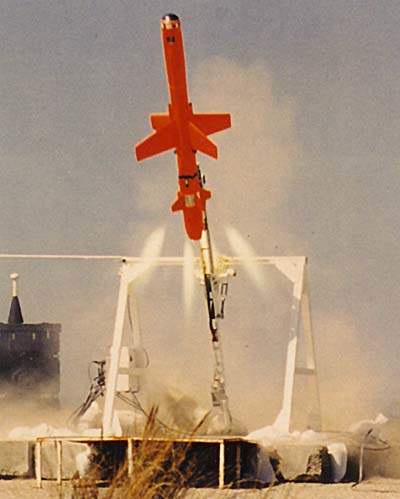The Polyphem fibre-optic-guided missile.
The Polyphem fibre-optic-guided missile prototype is designed for strikes at long-range targets from light land vehicles and against anti-ship or land based targets from the sea in which case the missile is launched from small ships or is helicopter launched. The Polyphem technology demonstrator programme began 1994 by Germany, France and Italy with Aerospatiale Matra Missiles (France), DaimlerChrysler Aerospace / LFK (Germany) and Italmissile (Italy). EADS/LFK and MBDA Missile Systems the participants.
In 1998, a contract was awarded for the operational demonstration phase. The aim of the trilateral fibre-optic guided missile system (TRIFOM) / Polyphem programme was to prove the functionality of a fibre-optic guided missile system and associated technologies. This demonstrator phase was concluded in 2002. The programme was cancelled in 2003.
Polyphem fibre-optic-guided missile system feautres
Polyphem has a range up to 60km and uses infrared imaging for high precision targeting by day and night against mobile or fixed targets. The images from an infrared camera in the nose of the missile are transmitted through a fibre-optic cable to a firing station, where they are automatically analysed, processed and displayed to the weapon system operator. The operator can then send the missile guidance instructions via the cable.
Ship launched fibre-optic guided missile
A ship-launched version, Polyphem-S, was suggested for the German Navy K-130 corvettes. A submarine-launched variant, to be called Triton, was also being considered with a solid rocket booster rather than the turbojet engine to be launched from a torpedo tube.
Polyphem firing station
The system, comprising a launcher for six missiles, can be mounted on a wheeled vehicle. The vehicle, which is air-transportable in C-160 and C-l30 transporter aircraft, provides modular armour protection against machine gun rounds and land mines.
The Polyphem firing station comprises a high-performance compact computer for missile guidance, an operator control panel and a high-resolution display.
The system uses advanced image processing algorithms, electro-optical converters and radio links. The firing station has a global positioning system (GPS) Navstar navigation reference unit, a north-seeking device and a command, control, communications and information (C3I) system interface. For mission planning, the firing station stores a digitised map and displays the map during missile flight. For some mission applications a dual monitor system can be used.
The Polyphem missile system is capable of fully automatic operation, with the operator as a “man in the loop”, validating the automatic selection and if necessary adjusting the final impact position to within 10cm. The operator is able to pick up the commands at any time, in order to control fire, to choose the point of impact as the missile approaches the target, and to obtain an immediate kill assessment.
The launch platform aligns the munition for firing and ensures the connection of the mechanical, electrical and optronic interfaces. A servo-assisted loading and reloading system allows easy handling of the munition.
Polyphem missile
The main subsections of the missile are the infrared sensor array and electronics, the warhead, the fuel tank and turbojet engine, the booster motor, battery, an actuator system and the fibre-optic bobbin and cable.
The infrared imager is mounted on a gyro-stabilised dual axis platform. The platinum silicide (PtSi) focal plane array provides high resolution images for target detection, discrimination and destruction, and for battlefield reconnaissance and damage control assessment. The quality of the image allows the operator to detect the targets at ranges up to 8km.
The navigation system comprises an inertial measuring unit (IMU) supported by an altimeter and GPS Navstar receiver, and ensures that the missile follows a predetermined trajectory into the designated target area.
The fibre-optic transmission system provides simultaneous optical transmission of video data from the missile to the ground station and of command data from the ground station to the missile at data rates of more than 200MB/s.
As well as a high data transmission rate, the fibre optic links provide immunity to active jamming and electro-magnetic interference.
The missile is accelerated by a solid propellant booster to an initial cruising speed of more than 150m a second. The multipurpose 15kg warhead consists of a hollow charge with a hull of splinters, ignition electronics, impact contact and safety devices.











